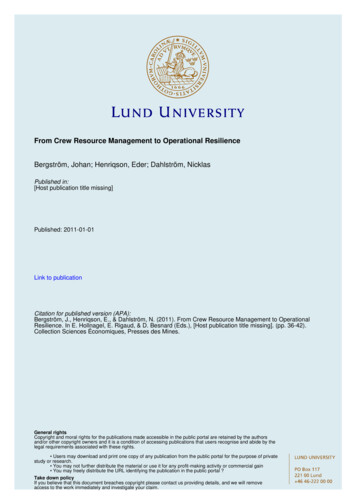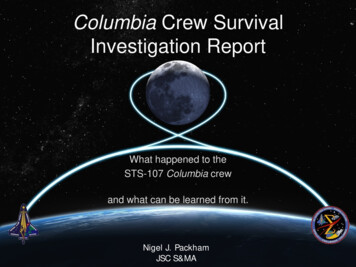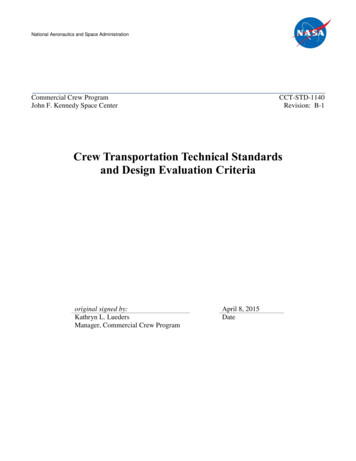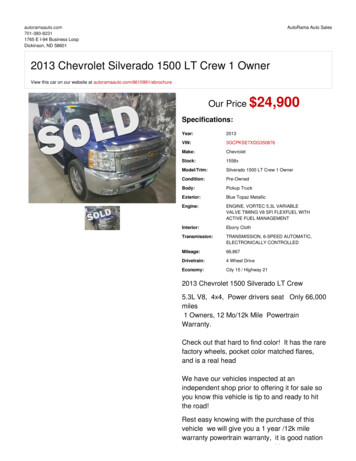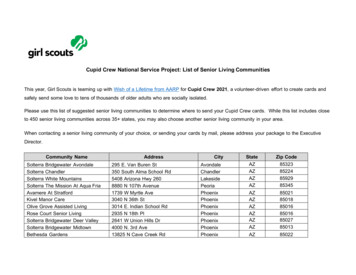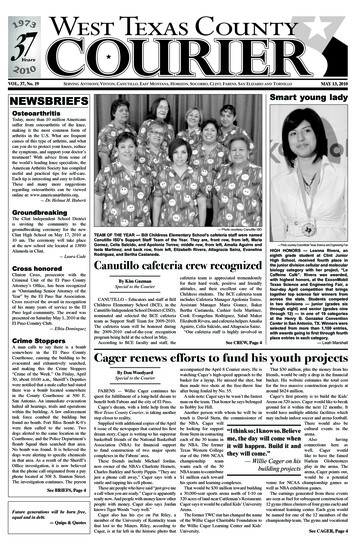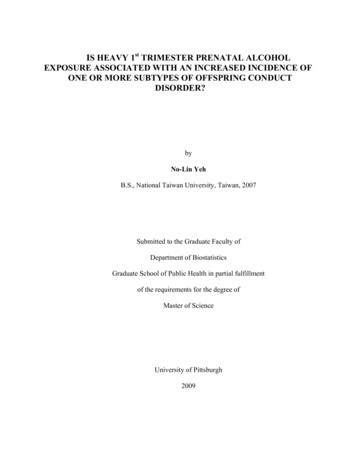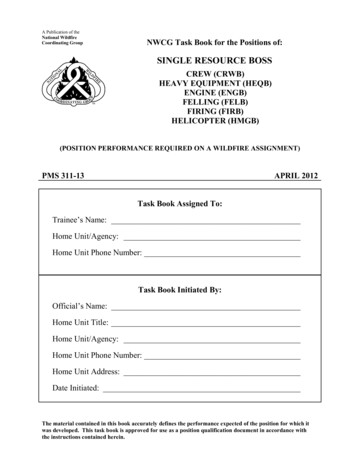
Transcription
A Publication of theNational WildfireCoordinating GroupNWCG Task Book for the Positions of:SINGLE RESOURCE BOSSCREW (CRWB)HEAVY EQUIPMENT (HEQB)ENGINE (ENGB)FELLING (FELB)FIRING (FIRB)HELICOPTER (HMGB)(POSITION PERFORMANCE REQUIRED ON A WILDFIRE ASSIGNMENT)PMS 311-13APRIL 2012Task Book Assigned To:Trainee’s Name:Home Unit/Agency:Home Unit Phone Number:Task Book Initiated By:Official’s Name:Home Unit Title:Home Unit/Agency:Home Unit Phone Number:Home Unit Address:Date Initiated:The material contained in this book accurately defines the performance expected of the position for which itwas developed. This task book is approved for use as a position qualification document in accordance withthe instructions contained herein.
Verification/Certification of Completed Task Bookfor the Position of:(position title)Final Evaluator’s VerificationTo be completed ONLY when you are recommending the trainee for certification.I verify that (trainee name) has successfullyperformed as a trainee by demonstrating all tasks for the position listed above and should beconsidered for certification in this position. All tasks are documented with appropriate initials.Final Evaluator’s Signature:Final Evaluator’s Printed Name:Home Unit Title:Home Unit/Agency:Home Unit Phone Number: Date:Agency CertificationI certify that (trainee name) has met allrequirements for qualification in the above position and that such qualification has been issued.Certifying Official’s Signature:Certifying Official’s Printed Name:Title:Home Unit/Agency:Home Unit Phone Number: Date:Additional copies of this publication are available through:NWCG, Publications Management System at ks2
NATIONAL WILDFIRE COORDINATING GROUP (NWCG)POSITION TASK BOOKNWCG Position Task Books (PTBs) have been developed for designated National InteragencyIncident Management System (NIIMS) positions. Each PTB lists the competencies, behaviorsand tasks required for successful performance in specific positions. Trainees must be observedcompleting all tasks and show knowledge and competency in their performance during thecompletion of this PTB.Trainees are evaluated during this process by qualified evaluators, and the trainee’s performanceis documented in the PTB for each task by the evaluator’s initials and date of completion. AnEvaluation Record will be completed by all evaluators documenting the trainee’s progress aftereach evaluation opportunity.Successful performance of all tasks, as observed and recorded by an evaluator, will result in arecommendation to the agency that the trainee be certified in that position. Evaluation andconfirmation of the trainee’s performance while completing all tasks may occur on one or moretraining assignments and may involve more than one evaluator during any opportunity.INCIDENT/EVENT CODINGEach task has a code associated with the type of training assignment where the task may becompleted. The codes are: O other, I incident, W wildfire, RX prescribed fire,W/RX wildfire OR prescribed fire and R rare event. The codes are defined as:O Task can be completed in any situation (classroom, simulation, daily job, incident,prescribed fire, etc.).I Task must be performed on an incident managed under the Incident CommandSystem (ICS). Examples include wildland fire, structural fire, oil spill, search andrescue, hazardous material, and an emergency or non-emergency (planned orunplanned) event.W Task must be performed on a wildfire incident.RX Task must be performed on a prescribed fire incident.W/RX Task must be performed on a wildfire OR prescribed fire incident.R Rare events such as accidents, injuries, vehicle or aircraft crashes occurinfrequently and opportunities to evaluate performance in a real setting are limited.The evaluator should determine, through interview, if the trainee would be able toperform the task in a real situation.While tasks can be performed in any situation, they must be evaluated on the specific type ofincident/event for which they are coded. For example, tasks coded W must be evaluated on awildfire; tasks coded RX must be evaluated on prescribed fire and so on. Performance of anytask on other than the designated assignment is not valid for qualification.3
Tasks within the PTB are numbered sequentially; however, the numbering does NOT indicatethe order in which the tasks need to be performed or evaluated.The bullets under each numbered task are examples or indicators of items or actions related tothe task. The purpose of the bullets is to assist the evaluator in evaluating the trainee; the bulletsare not all-inclusive. Evaluate and initial ONLY the numbered tasks. DO NOT evaluate andinitial each individual bullet.A more detailed description of this process and definitions of terms are included in theWildland Fire Qualification System Guide, PMS 310-1. This document can be found BILITIESThe responsibilities of the Home Unit/Agency, Trainee, Coach, Training Specialist, Evaluator,Final Evaluator and Certifying Official are identified in the Wildland Fire Qualification SystemGuide, PMS 310-1. It is incumbent upon each of these individuals to ensure their responsibilitiesare met.INSTRUCTIONS FOR THE POSITION TASK BOOK EVALUATION RECORDEvaluation Record #Each evaluator will need to complete an evaluation record. Each evaluation record should benumbered sequentially. Place this number at the top of the evaluation record page and also use itin the column labeled “Evaluation Record #” for each numbered task the trainee hassatisfactorily performed.Trainee InformationPrint the trainee’s name, position on the incident/event, home unit/agency, and the homeunit/agency address and phone number.Evaluator InformationPrint the Evaluator’s name, position on the incident/event, home unit/agency, and the homeunit/agency address and phone number.Incident/Event InformationIncident/Event Name: Print the incident/event name.Reference: Enter the incident code and/or fire code.Duration: Enter inclusive dates during which the trainee was evaluated.Incident Kind: Enter the kind of incident (wildfire, prescribed fire, search and rescue, flood,hurricane, etc.).Location: Enter the geographic area, agency, and state.Management Type or Prescribed Fire Complexity Level: Circle the ICS organization level(Type 5, Type 4, Type 3, Type 2, Type 1, Area Command) or the prescribed fire complexitylevel (Low, Moderate, High).4
Fire Behavior Prediction System (FBPS) Fuel Model Group: Circle the Fuel Model Groupletter that corresponds to the predominant fuel type in which the incident/event occurred.G Grass Group (includes FBPS Fuel Models 1 – 3):1 short grass (1 foot); 2 timber with grass understory; 3 tall grass (1½ - 2 feet)B Brush Group (includes FBPS Fuel Models 4 – 6):4 Chaparral (6 feet); 5 Brush (2 feet); 6 dormant brush/hardwood slash;7 Southern roughT Timber Group (includes FBPS Fuel Models 8 – 10)8 closed timber litter; 9 hardwood litter; 10 timber (with litter understory)S Slash Group (includes FBPS Fuel Models 11 – 13)11 light logging slash; 12 medium logging slash; 13 heavy logging slashEvaluator’s RecommendationFor 1 – 4, initial only one line as appropriate; this will allow for comparison with your initials inthe Qualifications Record.Record additional remarks/recommendations on an Individual Performance Evaluation, or byattaching an additional sheet to the evaluation record.Evaluator’s SignatureSign here to authenticate your recommendations.DateDocument the date the Evaluation Record is being completed.Evaluator’s Relevant Qualification (or agency certification)List your qualification or certification relevant to the trainee position you supervised.Note: Evaluators must be either qualified in the position being evaluated or supervise the trainee;Final Evaluators must be qualified in the trainee position they are evaluating.5
Common Tasks for All Single Resource BossesThis task book contains the tasks for all Single Resource Boss (SRB) positions. The common tasksfor all positions are listed first. These tasks need to be completed only once. The tasks specific toeach position are listed following the common tasks. If the trainee desires to qualify for more thanone position covered in this task book, they will need to complete the position specific tasks for eachposition they are seeking.Common Tasks for all SRBsCRWB Specific TasksHEQB Specific TasksENGB Specific TasksFELB Specific TasksFIRB Specific TasksHMGB Specific Taskspages 6 – 17page 18pages 19 – 22pages 23 – 25pages 26 – 27pages 28 – 290pages 30 – 34(Tasks 1 – 54)(Tasks 55 – 57)(Tasks 58 – 72)(Tasks 73 – 87)(Tasks 88 – 93)(Tasks 94 – 99)(Tasks 100 – 122)Competency: Assume position responsibilities.Description: Successfully assume role of Single Resource Boss and initiate position activities at theappropriate time according to the following behaviors.TASKCODEEVAL.RECORD#EVALUATOR:Initial & dateupon completionof taskBehavior: Ensure readiness for assignment.1. Obtain and assemble information and materials neededfor kit. Suggested items: PMS 461, Incident Response Pocket Guide (IRPG) PMS 410-1, Fireline Handbook Incident specific reference materials Documentation materialsO2. Obtain complete information from dispatch uponassignment. Incident name Incident order number Request number Incident phone number Reporting time Reporting location (drop point) Transportation arrangements/travel routes Contact procedures during travel (telephone/radio) Authorization for use of equipment (laptops, cellphones, rental vehicle)OEvaluate the numbered tasks ONLY. DO NOT evaluate bullets; they are provided as examples/additionalclarification.6
Common Tasks for All Single Resource BossesTASKCODE3. Travel to and from assignment. Have assigned personnel ready at specifiedlocation on time. Arrange tool transport. Manifest assigned personnel for helicopter, ifneeded. Use time effectively during delays (e.g., critiqueassignment). Take head count prior to departure. Ensure driver/operator is qualified and has hadrequired rest. Ensure safety procedures are followed fortransporting personnel and equipment.O4. Arrive at incident and check in. Arrive properly equipped at assigned locationwithin acceptable time limits. Notify dispatch of any time delays.IEVAL.RECORD#EVALUATOR:Initial & dateupon completionof taskBehavior: Ensure availability, qualifications, and capabilities of resources to completeassignment.5. Assemble personnel. Notify crew members of assignment for timelymobilization. Assemble assigned personnel at rendezvous pointat time required.O6. Inspect personnel and equipment. Verify qualifications. Ensure safety equipment and personal gear meetminimum requirements in the Fireline Handbook. Assess capabilities of personnel to safely completeassignment. Ensure tools and equipment are ready for travel.O7. Determine assignments and personal equipment needs. Check tools, supplies, and radios.OEvaluate the numbered tasks ONLY. DO NOT evaluate bullets; they are provided as examples/additionalclarification.7
Common Tasks for All Single Resource BossesTASKCODEEVAL.RECORD#EVALUATOR:Initial & dateupon completionof taskBehavior: Gather, update, and apply situational information relevant to the assignment.8. Obtain initial briefing from supervisor. Tactical assignment. Special considerations and hazards. Values to be protected.I9. Brief supervisor about readiness of assigned personnel.IBehavior: Establish effective relationships with relevant personnel.10. Conduct self in a professional manner. Respectful and courteous. Respectful of public and private property.I11. Establish and maintain positive interpersonal andinteragency working relationships.IBehavior: Establish organization structure, reporting procedures, and chain of commandof assigned resources.12. Organize assigned resources into configurations whichwill meet incident/tactical objectives.IBehavior: Understand and comply with ICS concepts and principles.I13. Apply the ICS. Follow chain of command. Maintain appropriate span of control. Use appropriate ICS forms. Use appropriate ICS terminology.Evaluate the numbered tasks ONLY. DO NOT evaluate bullets; they are provided as examples/additionalclarification.8
Common Tasks for All Single Resource BossesCompetency: Lead assigned personnel.Description: Influence, guide, and direct assigned personnel to accomplish objectives and desiredoutcomes in a rapidly changing, high-risk environment.TASKCODEEVAL.RECORD#EVALUATOR:Initial & dateupon completionof taskBehavior: Model leadership values and principles.14. Exhibit principles of duty. Be proficient in your job, both technically and as aleader. Make sound and timely decisions. Ensure tasks are understood, supervised andaccomplished. Develop your subordinates for the future.I15. Exhibit principles of respect. Know your subordinates and look out for theirwell-being. Keep your subordinates informed. Build the team. Employ your subordinates in accordance with theircapabilities.I16. Exhibit principles of integrity. Know yourself and seek improvement. Seek responsibility and accept responsibility foryour actions. Set the example.IBehavior: Ensure the safety, welfare, and accountability of assigned personnel.17. Provide for the safety and welfare of assignedresources. Recognize, mitigate and communicate potentiallyhazardous situations. Monitor condition of assigned resources. Account for assigned resources. Provide for care of assigned resources and notifysupervisor in event of sickness, injury, or accident. Utilize Risk Management Process.IEvaluate the numbered tasks ONLY. DO NOT evaluate bullets; they are provided as examples/additionalclarification.9
Common Tasks for All Single Resource BossesTASKCODE18. Follow safety guidelines. Inform subordinates of hazards. Develop plans based on safety guidelines. Ensure tactical operations maintain the principlesof Lookouts, Communication, Escape Routes,Safety Zones (LCES). Ensure work/rest guidelines are met.IEVAL.RECORD#EVALUATOR:Initial & dateupon completionof taskBehavior: Establish work assignments and performance expectations, monitorperformance, and provide feedback.19. Complete daily review of staffing requirements.I20. Develop schedule/assignments based on IncidentAction Plan (IAP) or relevant plan.I21. Ensure subordinates understand assignment foroperational period. Provide clear, concise instructions and allow forfeedback.I22. Continually evaluate performance. Communicate deficiencies immediately and takecorrective action. Provide training opportunities where available. Complete personnel performance evaluationsaccording to agency guidelines.IBehavior: Emphasize teamwork.I23. Establish crew cohesiveness. Provide for open communication. Seek commitment. Set expectations for accountability. Focus on the team result.Evaluate the numbered tasks ONLY. DO NOT evaluate bullets; they are provided as examples/additionalclarification.10
Common Tasks for All Single Resource BossesTASKCODEEVAL.RECORD#EVALUATOR:Initial & dateupon completionof taskBehavior: Coordinate interdependent activities.24. Coordinate tactical operations with adjoining resourcesand supervisor.I25. Communicate changes with adjoining resources andsupervisor. Movement of resources Tactical decisions Logistical needsIEvaluate the numbered tasks ONLY. DO NOT evaluate bullets; they are provided as examples/additionalclarification.11
Common Tasks for All Single Resource BossesCompetency: Communicate effectively.Description: Use suitable communication techniques to share relevant information with appropriatepersonnel on a timely basis to accomplish objectives in a rapidly changing, high-risk environment.TASKCODEEVAL.RECORD#EVALUATOR:Initial & dateupon completionof taskBehavior: Ensure relevant information is exchanged during briefings and debriefings.26. Brief and keep subordinates informed and updated. Operational assignments and changes. Readiness for next operational period. Work/rest guidelines. Camp layout.I27. Exchange information with resources from previousoperational period.I28. Brief relief forces. Current status/conditions/concerns regardingassignment.I29. Attend briefings and meetings as directed. Provide information as requested. Keep supervisor informed of issues and potentialproblems.I30. Participate in functional area briefings and conductAfter Action Reviews (AARs).IBehavior: Ensure documentation is complete and disposition is appropriate.31. Complete time reports for assigned personnel. Ensure reports are accurate and submitted in atimely manner. Include justifications and authorizations as needed.O32. Complete personnel evaluations. Review with individual personnel prior to leavingincident. Provide copy of review to individual.IEvaluate the numbered tasks ONLY. DO NOT evaluate bullets; they are provided as examples/additionalclarification.12
Common Tasks for All Single Resource BossesTASKCODE33. Complete ICS 214, Unit Log.O34. Complete necessary medical forms in event of aninjury.OEVAL.RECORD#EVALUATOR:Initial & dateupon completionof taskBehavior: Gather, produce and distribute information as required by establishedguidelines and ensure understanding by recipient.35. Obtain additional sources of information to performoperational assignment. Local maps Local safety concerns Pocket cards IRPG Fireline HandbookOBehavior: Communicate and ensure understanding of work expectations within the chainof command and across functional areas.O36. Communicate using clear text.Behavior: Develop and implement plans and gain concurrence of affected agencies and/orthe public.37. Ensure tactical plans conform to incident objectives.IEvaluate the numbered tasks ONLY. DO NOT evaluate bullets; they are provided as examples/additionalclarification.13
Common Tasks for All Single Resource BossesCompetency: Ensure completion of assigned actions to meet identifiedobjectives.Description: Identify, analyze, and apply relevant situational information and evaluate actions tocomplete assignments safely and meet identified objectives. Complete actions within :Initial & dateupon completionof taskBehavior: Gather, analyze, and validate information pertinent to the incident or event andmake recommendations for setting priorities.38. Evaluate fuels, topography, and weather factorsthroughout entire operational period. Monitor and ensure documentation of weatherobservations (e.g., identify trends). Communicate to subordinates and supervisor (e.g.,update weather changes, fire weather forecasts).39. Request, direct, and provide feedback for aerialresources through established chain of command.W/RXW40. Recon area of assigned responsibility, consult withsupervisor on resource needs and suggest adjustmentsas necessary.I41. Identify road systems and limitations. Bridge load and road limits Ingress/egress Effects of weatherIBehavior: Take appropriate action based on assessed risks.42. Apply the Risk Management Process found in theIRPG and Fireline Handbook. Step 1: Situation Awareness Step 2: Hazard Assessment Step 3: Hazard Control Step 4: Decision Point Step 5: EvaluateIEvaluate the numbered tasks ONLY. DO NOT evaluate bullets; they are provided as examples/additionalclarification.14
Common Tasks for All Single Resource BossesTASKCODE43. Develop strategy and apply appropriate tactics for theassignment. Fireline type, location, and construction Ignition operations Equipment use Water use Mop-up, hold, and patrolW44. Recognize situation requiring public evacuation andcommunicate to supervisor. Immediate need Planned actionREVAL.RECORD#EVALUATOR:I
training assignments and may involve more than one evaluator during any opportunity. INCIDENT/EVENT CODING . Each task has a code associated with the type of training assignment where t

